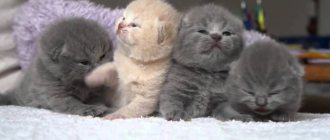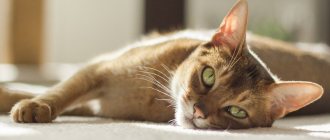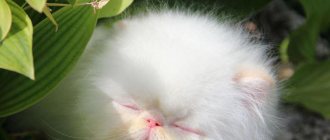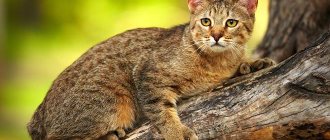Features of the development of six-month-old kittens
The developmental characteristics of kittens at 6 months vary significantly depending on the breed, living conditions and quality of care. Most outbred cats, at six months of age, are sexually mature, the cats begin to mark, and the cats are ready for mating. With purebred animals the situation is slightly different; six months of age is considered the threshold at which sexual formation begins.
A six-month-old kitten does not yet have enough skills to be considered an adult animal, but it is no longer a child either.
- By the age of 4–5 months, 40% of kittens develop lactose intolerance, which indicates that they are ready to fully transition to adult food.
- At the age of 6–7 months, the first molt occurs, during which the kitten gets rid of baby fluff and acquires adult hair, and if winter is ahead, also undercoat.
The diet of a 6-month-old kitten should be made taking into account all physiological needs: active bone growth, the final stage of eruption of chewing molars, the formation of an adult coat, more aggressive intestinal microflora and taste preferences that the pet will adhere to for the rest of its life.
Creating Good Habits
Your six month old kitten is definitely becoming more individual and developing behaviors that he will follow throughout his life. Kitten - 8 weeks to about one year of age is the ideal time to help your pet develop good habits to make him a model pet into adulthood and beyond.
“Take time to help your kitten become comfortable with the experiences he will encounter in his life: car rides, grooming, ear cleaning, teeth brushing, nail trimming, unfamiliar surroundings, unfamiliar sounds, unfamiliar people in his house, etc. etc.,” says Pam. She also gives tips on how to help your kitten learn good litter box habits.
First, if you haven't already, provide a litter box that is easy for your kitten to climb into. “A litter box with high sides will be too difficult for a teenager, especially one with a full bladder,” she says. "Keep in mind that a kitten won't have the bladder control that an adult cat does, so when he needs to go to the toilet, it's usually urgent."
You can start offering a larger litter box once your kitten is 6 months old and becomes more familiar with using the litter box. “Place a larger cell next to a smaller one to begin the gradual transition,” suggests Pam. "You can even place a smaller litter box inside a larger one so she can get used to the new environment."
What to feed a 6 month old kitten
If you become the owner of a six-month-old kitten, it is advisable to find out what he was fed before moving into your home. If such information is not available, for example, you bought a kitten at a poultry market or picked it up on the street, you need to create a diet based on the urgent needs at the moment.
When deciding what to feed your kitten, you need to choose between three basic options:
- Natural feeding.
- Industrial feeding.
- Mixed feeding
Mixed feeding is not recommended by veterinarians and prepared food manufacturers, although it is practiced by thousands of owners. Mixed feeding involves preparing a diet from ready-made feed and natural products.
Typically, the cat receives ready-made food for breakfast and food prepared from natural products for dinner.
A mixed type of feeding is a direct path to dysbiosis, and this, in turn, is the first reason for inadequate absorption of food.
Natural products
A natural diet is considered more natural for a cat, however, when preparing it, it is necessary to take into account the peculiarities of physiology. When developing a menu, you need to rely on one of three methods of natural feeding:
- Raw and cooked foods, pure and mixed.
- Exclusively raw products.
- Semi-finished products from natural homemade products.
Summary of caring for a 6 month old kitten
In short, you can help your kitten develop into a friendly and affectionate adult cat by taking the time to show him that the world is a safe place. As Pam says, “Kitten is a wonderful and fun time, but it is also a time for him to learn and process the experience. The more time you spend gradually introducing your kitten to new things, the more likely he is to be more receptive to these experiences later in life, which will reduce everyone's stress levels."
About the Author Stacy N. Hackett, a lifelong cat owner, writes frequently about cats, cat breeds, and a variety of pet-related topics. Her writing inspiration comes from her cats, Jack and Katie, and her cocker spaniel/labrador mix, Maggie.
Feeding mode
For normal growth and development of a kitten, it is extremely important to adhere to the feeding regime and correctly calculate the amount of food needed to compensate for basic physiological needs. To be sure that you do not overfeed the kitten, the serving size must be calculated using the following algorithm:
- Calculate the daily feed intake based on caloric content and protein content.
- Divide the daily feed amount by the number of feedings.
At the age of 6 months, kittens become active at certain times of the day. After a period of activity, the kitten should receive a full portion of food; if the baby just woke up or got hungry while resting, a snack will be enough. In total, during the day, the kitten should eat 4-5 times and have a snack 1-2 times.
Care and maintenance of Scottish cats
Unlike many of their purebred counterparts, Scottish Straights are not demanding or needy to care for. But this does not mean that the lucky person who bought a Scottish kitten is forever freed from any responsibilities. As soon as the little playful creature crosses the threshold of the house, a new stage of life begins for its owner, associated with caring for a teddy cat bear. A straight-eared pet needs attentive and careful treatment and periodic health-improving and preventive measures.
- Grooming. It will take the most time to care for your cat's luxurious coat. Experts advise brushing fluffy cats once a week with a soft brush. Its natural pile should be moderately hard. Scots have a naturally smooth coat that does not tangle. Like other neat cats, Scottish cats keep their fur clean by licking it.
Due to the thick coating, the sensitive intestines may become blocked by a plug of cat hair. This usually leads to serious digestive problems. Therefore, veterinarians advise giving domestic kitties a special paste to remove hairballs.
Scottish cats are bathed as needed, no more than once a month, with the obligatory addition of specialized shampoos.
- Hygiene procedures. Obedient furry cats need their nails trimmed periodically. To do this, use scissors or tweezers. After a “manicure,” the owner should treat each finger with peroxide or a solution of potassium permanganate to prevent infection from entering the body.
The ears need to be cleaned with a cotton swab; this is usually done before bathing the cat. The large and radiant eyes of straights should be wiped with a damp cloth that does not contain “chemicals”.
With careful care, Scottish Straights can live 14-18 years.
Where to buy a straight-eared Scottish kitten
Little bundles can bring a lot of joy to your home. But it’s better to buy them not on Avito, but from certified Scottish straight-eared breeders. Kittens purchased from nurseries are prepared, have no diseases, are litter box trained and have a pedigree. But don’t forget to prepare yourself: purchase a tray, toy and food for the new family member in advance.
The price for a Scottish Straight kitten in Russia starts from 9,000 rubles
. Most of the cost of a kitten is determined by its color.
Breeding nurseries:
- Ermine Trace - Moscow
How to name a Scottish Straight kitten
Getting a kitten is half the battle; he still needs to come up with a name.
After all, the name of a pet is an important component of the life of both the animal and its owner. Straight-eared cats quickly get used to the nickname and respond to it. You can use the suggested nicknames for straight-eared Scots. Table of nicknames for straight-eared Scottish cats
| Girl | Boy | ||
| Abi Asya Buffy Blanca Bianca Waffle Vita Gadget Gretta Dymka Zora Toffee | Laima Mulya Nyuta Paprika Sandra Snezha Tara Toira Tori Fanya Chipa Sherry | Agate Aiko Ice Archie Barry Bars Belyash Vaigar Gizmo Gray Dick Zeus | Iris Cupcake Lex Magnus Murzik Oscar Ray Simba Troyan Fantik Hoshiko Shanti |
Breed health
Scots with straight ears are a breed with good health and reliable immunity. They will delight their households for a long time with their cute faces and kind, gentle disposition. Unlike their lop-eared relatives, they managed to avoid genetic abnormalities and dangerous diseases. However, Scottish Straights are recommended to visit the veterinarian's office several times a year to prevent illness. Owners should check the condition of their ears and teeth from time to time.
Water in a kitten's diet
Water plays a fundamental role in metabolism and the process of hematopoiesis. Thick blood makes it difficult for all organs to function and slows down metabolism. If the water-salt balance is disturbed, and this is possible if the kitten does not receive enough water, the pet grows or develops untimely.
To avoid health problems, make sure your kitten has easy access to water. If necessary, place several additional drinking bowls in your home, but do not forget to regularly change the water in them. The water must be fresh, because if it sits in a bowl for 10–12 hours, bacteria will begin to multiply in it, and this is one of the causes of indigestion and problems in the gastrointestinal tract.
Prepare your 6 month old kitten for grooming
The gradual introduction of new products also applies to care tools. As you get your 6 month old kitten accustomed to regular handling of his paws, mouth and body, you are helping him prepare for regular grooming tasks. Brushing sessions can be a great time for you to bond with your pet, and if he is already accustomed to your touching his paws and mouth, he will be more receptive to additional grooming tasks such as nail trimming and teeth brushing.
Vitamins and supplements
When kept on high-quality, industrial feed, vitamins and additives are not required. It is important to understand that an excess of vitamins and microelements is no less dangerous than their deficiency. With a natural feeding method, vitamin supplements should be present in the diet on an ongoing basis at least until the age of one year.
A kitten can get basic vitamins and nutrients from natural products:
- Meat and bone meal.
- Fish, chicken, beef liver.
- Greens, vegetables, fruits.
- Sunflower oil, olive oil.
- Brewer's yeast.
Appearance of a Scot at 8-9 months
The appearance of a Scottish cat and a cat at 8 months has already formed, but they will still grow at a low rate until 2 years. By that time, the coat color and eye color will also finally receive its depth. But at 8 months, the fur and eyes already have a color that can be identified without problems. At an earlier age there are sometimes problems with this.
Article continues after advertisement
In general, the cat is almost a year old, which means that they have already matured physically. A Scottish cat at this age already weighs 3.5-5 kg, a cat - 4-5.5 kg. Size and weight depend on genetics, as well as the quality of nutrition.
Photos of Scottish cats at 8 months
The final maturation of the kitten
As practice shows, a cat becomes an adult by about 18 months of age, regardless of the individual characteristics of the animal. At this stage, cats are fully formed not only physically, but also socially. This statement does not apply to sterilized animals. Such cats, due to hormonal changes in their bodies, are characterized by more “childish” behavior. They can be more playful and spontaneous than unsterilized cats.
Many people are surprised by the fact that adult cats retain the same playfulness and curiosity as kittens. In fact, this is completely normal. Cats are very active and mobile animals, so it is not at all shameful for them to show playfulness and curiosity even at an advanced age. Such behavior for an animal is not at all a sign of insufficient maturity.
How much should a cat eat per day?
To keep your pet healthy and alert, its diet must be nutritious and balanced. It is the nutritional value of the product that determines how many times a day you need to feed your cat. The amount of food eaten during the day should be no more than 7.5% of the animal’s weight.
The dosage of ready-made food is indicated on the packaging, and with natural feeding, the cat needs to eat up to 150 g of meat or fish per day, which is 50% of the daily protein intake. The natural diet is supplemented with fermented milk products, cereal porridges, seasonal vegetables, vitamins and mineral nutritional supplements. Meal frequency – 2 times a day.
- Can I have a piece?
The diet of a pregnant cat should have an increased energy value: contain more vitamins and minerals, but not increase the calorie content of the product. Increase the frequency of feedings up to 4-5 times, maintaining the usual serving size. A nursing cat is also provided with frequent feeding, while increasing the volume and calorie content of food.
Note! It is better to prepare the diet for a pregnant or lactating cat after consultation with a veterinarian











